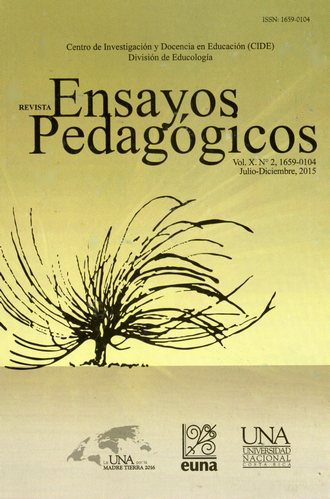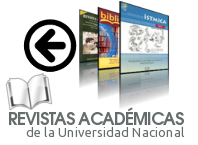The Digital Whiteboard: A Teaching Resource for Visualization and Academic Interaction in Higher Education
DOI:
https://doi.org/10.15359/rep.10-2.7Keywords:
interactive digital board, concept maps, interactive response systemsAbstract
In this paper, we reflect on the role of the interactive digital board as a central element for visualizing and interacting with other digital tools used to enhance university students’ educational experiences. Particularly, the different possibilities for interactivity that can be achieved with the existing programs on a computer that integrates an interactive digital board are analyzed. We will also discuss the combined use of interactive digital boards with interactive response systems in the classroom and concept maps that can be created with a digital board. We will also comment on some previously reported findings and make a series of concrete proposals for potential uses of the interactive digital board in other didactic situations.
References
Aguilar, R.A. y Ramírez-Martinell, A. (2014). La Pizarra Digital Interactiva: Componentes, configuraciones posibilidades y singularidades. Revista Ensayos Pedagógicos, 9 (1), 137-158.
Akinator. (2014). Akinator. Recuperado de http://es.akinator.com
ALICE. (2014). A. L. I. C. E. The Artificial Linguistic Internet Computer Entity. Recuperado de http://alice.pandorabots.com
Arena. (2014). Arena Simulation software, Rockwell Automation. Recuperado de https://www.arenasimulation.com
Armstrong, V., Barnes, S., Sutherland, R., Curran, S., Mills, S. y Thompson, I. (2005). Collaborative research methodology for investigating teaching and learning: the use of interactive whiteboard, technology. Educational Review, 57(4).
Cañas, A. J., Hill, G., y col. (2004). CMapTools: A Knowledge Modeling and Sharing Environment. En Cañas, A. J., Novak, J. D., y González, F. M. (Eds.). Concept Maps: Theory, Methodology, Technology. Proceedings of the First International Conference on Concept Mapping, Pamplona, España.
Domingo, M. y Marquès, P. (2011). Classroom 2.0, Aulas 2.0 y uso de las TIC en la práctica docente, Comunicar, 19(37), 169-174. Recuperado de http://dx.doi.org/10.3916/C37-2011-03-09
Gallego, G., Cacheiro, M. L. y Dulac, J. (2009). La pizarra digital interactiva como recurso docente. En Ortega, S. I. y Ferrás, S. C. (Coord.) Alfabetización Tecnológica y desarrollo regional [monográfico en línea]. Revista Electrónica Teoría de la Educación: Educación y Cultura en la Sociedad de la Información, 10(2), 127-145.
Guerrero, J. (2009) Introducción de las pizarras digitales interactivas en la enseñanza presencial y no presencial. En IV Jornadas Nacionales sobre el Espacio Europeo de Educación Superior, España.
Guerrero, R. y García, A. (2012). Metodología para el diseño y desarrollo de ontologías en el campo de la educación. Revista Cubana de Ciencias Informáticas, 6(2), 1-11.
Hervás G. C., Toledo, M. P. y González, F. M. (2010). La Utilización Conjunta De La Pizarra Digital Interactiva Y El Sistema De Participación Senteo: Una Experiencia Universitaria. Pixel-Bit. Revista de Medios y Educación, 36, 203 – 214,
Jara, A. J., Santa, J., Zamora, M. A., Villalba, G., Guirao, A. y Pinaz, R. (2011). Transferring Experience In Digital Board And Classroom Response System From The Computer Science Faculty To High Schools Proceedings. En INTED2011 Conference, Valencia, España.
León, M., Martínez, N. y García, Z. (2012). Nuevo enfoque para desarrollar sistemas de enseñanza-aprendizaje inteligentes usando MC y razonamiento basado en casos. Revista Cubana de Ciencias Informáticas, 1(3), 58-69.
Lesson Activity Toolkit. (2011). Curso de Lesson Activity Toolkit 2.0. Recuperado de toolkit.notebook
Marín, A. A., Figueroa, Y., Alonso, G., Cruz, Y. y Rosete, A. (2015). Juego Computacional para adultos basado en Mapas Conceptuales. En XI Congreso Internacional de Informática en la Educación, XI Convención Internacional Informática, La Habana, Cuba.
Marquès, P. (2006). La pizarra digital en el aula de clase. España: Edebé.
Martínez, K.P (2015). La educación superior en la era de Internet: nuevas ecologías de aprendizaje. En A. Ramírez-Martinell y M. A. Casillas. Háblame de TIC volumen 2: Internet en Educación Superior. Argentina: Brujas – Social TIC.
Mitrović, D., Ivanović, M., Burkhard, H. (2013): Intelligent Jason Agents in Virtual Soccer Simulations, Multiagent System Technologies. Lecture Notes in Computer Science, 80(76), 334-345.
Noda H. A. (2009). Pizarra digital interactiva en aulas de matemáticas. Números, Revista didáctica de las matemáticas, 72, 121–127.
Portencasa, R. (2008). Las tecnologías al servicio de la sociedad. Revista Cubana de Ciencias Informáticas, 2(3), 5-14.
Quiroz, M. (2012). Entrenamiento Básico, Manual de Guía para el docente, Utilización del Software Educativo ActivInspire, Promethean Inc.
Sáez, J. M. (2011). Effective Use Of Information And Communication Technologies: Assessment Of The Positive Impact Of Slide Show Applications In Classroom Practice. En 7th International Scientific Conference eLearning and Software for Education, Bucharest.
Siemens, G. (2010). Conociendo el conocimiento. (E. Quintana, D. Vidal, L. Torres, y V. Castrillejo, Trans.) (pp. 1–182). Recuperado de http://www.nodosele.com/editorial/
Spector, J. M. (2013). Emerging educational technologies: Tensions and synergy, Journal of King Saud University. Computer and Information Sciences 26, 5–10. Recuperado de http://dx.doi.org/10.1016/j.jksuci.2013.10.009
UNESCO (2008) Estándares UNESCO de competencia en tic para docentes [Consultado el 6 de mayo de 2012].
Wood, R. y Ashfield, J. (2008). The use of the interactive whiteboard for creative teaching and learning in literacy and mathematics: a case study. British Journal of Educational Technology, 39(1), 84–96.
Downloads
Published
How to Cite
Issue
Section
License
Ensayos Pedagógicos is subscribed to the Attribution-NonCommertial-NoDerivatives 4.0 International Creative Commons Licence, which allows both authors and readers to freely download, store, copy, and distribute the final approved publisehd version of the manuscript (post-print) as long as this is done without commercial purposes, no derivative works are generated, and the source and author are mentioned. As well, Ensayos Pedagógicos declares that authors will remain the rightful owners of the copyrights of their work in perpetuity.







